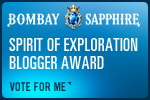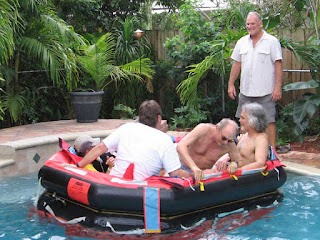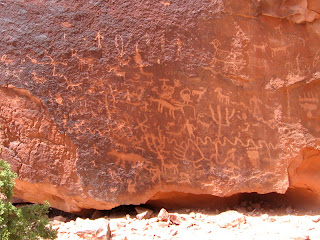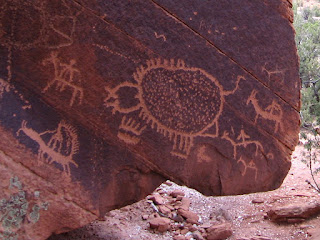This blog post is one I have been thinking about since I returned from my trip to Savannah back in mid-April. I almost skipped writing it entirely because it will prove to be a little embarrassing, but this blog is supposed to be about sailing, and sailing necessarily involves a healthy dose of learning from mistakes. So here it is:
Near the end of the Savannah trip, on the Friday before the weekend when family would start returning home, I invited everyone out for a sail on Whispering Jesse. My mother stayed behind, but my father, my sister Jane, her husband Josh, their twin sons Max and Ben, and my sister Susan were all up for it. So Nan and I spent some early morning time at the marina that day getting the boat ready: taking off the sail cover, replacing a missing mainsheet shackle, spraying the luff track with SailKote lubricant, and listening to the weather on the VHF. It was looking dark and blustery out to the east in the open ocean, and I was concerned that there might be too much wind for comfort. I checked the wind instruments and they were showing about 15 knots out of the east, counter to the prevailing westerlies.
When six family members arrived at a little after 9:00, we welcomed them aboard and gave them a quick tour of the boat. I had checked the tide table and the current would be running lightly against us as we backed out of the slip. With the transmission in reverse, we cast off the dock lines, and moved slowly back against the current, assisted by the wind. I put the transmission into forward and made a smooth turn to starboard to put us out into Delegal Creek, heading down the estuary toward Ossabaw Sound. We followed the line of channel markers out toward open water and were surprised when the depth meter continued to register single digits of foot depth under the keel. Slack tide would not occur until 1:00 in the afternoon, so shallow water was to be expected, but we were more than a half-mile from shore. In addition to being shallow, Ossabaw Sound is also prone to shoaling, and we lightly bounced the keel over a few sandy ones as we headed out to sea.
The current was flowing opposite the wind, creating significant chop and whitecaps and making for a bumpy ride. I let my nephews, who are learning to sail dinghies at home in Seattle, take turns at the wheel, but they didn't seem too confident with steering a larger boat in choppy conditions and willingly relinquished control back to me. We continued to motor out through the waves, spraying the people sitting up at the bow who were looking for dolphins. When we reached a depth where it would have been safe to head directly into the wind and raise the mainsail, I decided against it. It was just a little too rough for inexperienced sailors and I didn't want to scare anyone. Instead, we turned around and headed in for calmer waters. We followed the southern shore of Skidaway Island for a ways, spotting several dolphins in the shallow waters, until everyone was ready to return to shore.
I phoned Jimmy, the dockmaster, as we passed the channel's entrance markers, and asked if he could meet us at the pier to receive a dock line. He said he would, and he was standing at the corner of the fuel dock as we approached. It is difficult to judge current from a moving boat, so it did not appear that it was running significantly faster than it had been when we departed almost two hours before, but it most definitely was. To steer the boat back into the slip, I would need to make a tight 180-degree turn to starboard against the current. As I began the turn, putting the boat's beam to the current, the force of the water started pushing the boat sideways, leaving no room to complete the turn. I cranked the transmission into reverse, to back up against the current and get the bow pointed at the slip, but the little folding, two-blade propeller was no match for the strong current. The boat crashed sideways into a barnacle-encrusted piling and my neighbor's bow anchor, and there we were pinned. We quickly moved fenders into position to keep the anchor and piling from grinding against the hull and cap rail and causing further damage. And then we tried to figure out what to do. Jimmy had climbed over the neighbor's boat to see how he could help and said that he didn't think we would be able to move the boat until slack tide, still a couple of hours away. He then assisted everyone but Nan, my father and me in getting off the boat by way of the neighbor's boat. One of my sisters had called my mother and she arrived to take the rest of the group back home.
We were resigned to waiting for slack tide until Joel and his wife Bonnie, who own a Cat Ketch they keep at a slip across from ours, came over to see how they could help. Joel is an old salt and according to Bonnie, he has extensive experience with boat rescues. He suggested floating a long anchor line down from the adjacent pier, tying it off at the bow and using it in conjunction with a stern line, to control the boat's rotation, to pull the boat across to an empty slip at the adjacent pier. It worked like a charm. We didn't even need to use the engine; it just took Joel and a marina employee to pull the boat over while I steered. My father, Nan and I secured the boat in the slip to await slack tide and thanked everyone for their help. Joel said he would be around later if we needed assistance with getting the boat back into her own slip, and we told him that after the morning's experience, we would appreciate all the help we could get.
After lunch, my father, Nan and I returned to the marina to find the water almost motionless. Joel was expecting us, and he suggested using the anchor line again but as a safety measure this time. He tied it to a stern cleat and played it out like a leash as I backed out of the slip, turned the stern to port, put the transmission into forward, and turned to starboard to slowly glide into the opposite slip. Jimmy was waiting to receive a dock line, and we soon had the boat secured in her home slip. We thanked Joel and Jimmy profusely and headed for home.
Nan and I decided we owed Joel a thank-you gift and went to find a liquor store for a good bottle of wine. When we returned to the marina, Joel and Bonnie were working on replacing the portlights on their boat. We gave them the wine and thanked them again for their help. We got to talking boats, and Bonnie said that people walking on the pier frequently stopped to admire Whispering Jesse, that she is such a pretty boat. She asked if she could see what the boat was like on the inside. We said sure and opened her up for a little tour. Bonnie commented about the roomy cabin and its abundant storage space as I showed them around and answered their questions.
Back on the pier, Joel and I assessed the damage to the boat's starboard beam. There were some deep gouges in the teak cap rail and in the fiberglass below from the flukes of my neighbor's anchor, and some significant scratching from the barnacles on the piling, but it was all merely cosmetic and could be made to look as good as new. All in all, we were lucky that it wasn't much worse. Joel said he knew a guy who specialized in boat carpentry who could take care of the cap rail and any other wood-related issues. I told him I would get his phone number when I returned to Savannah, which is now starting to look like next Thanksgiving weekend.
I talked with Jimmy the next day when we sought him out to give him a tip for his services. He said that he would have been fine with me just pulling the boat up to the fuel dock and leaving her there until slack tide before moving her into her slip. How I wish he had suggested that when I called him to take a dock line!
The moral of this story: Tides and currents are serious forces, especially in tight quarters where they make maneuvering extremely difficult. Check the tide tables, and try to time marina arrivals and departures to correspond with the slack tide periods between ebbs and flows. When in doubt, stay put if you're already secure, and look for temporary alternatives, like anchoring or tying up at an easier location, if you're trying to dock. Most importantly, don't be in a hurry. Take the time to evaluate the situation and make a common-sense plan. Someday, I hope to have enough time to take my own advice.

 Raising Charlie: The Lessons of a Perfect Dog
Raising Charlie: The Lessons of a Perfect Dog














